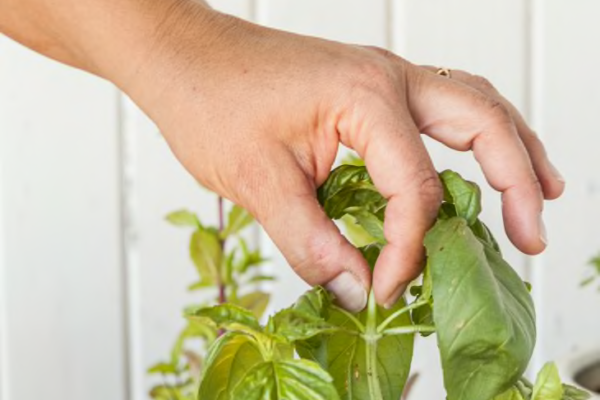Basil is one of the most popular herbs in the garden for good reason! A member of the mint family, this versatile herb is an essential ingredient in Mediterranean and Asian cuisines, and loves being added to just about anything—from soups and salads to grilled meat and seafood dishes to sandwiches and spreads. Fresh basil leaves have an aromatic, slightly peppery flavor that complement a wide variety of dishes, from the savory to the sweet.


FAST FACTS
Benefits and nutritional information:
- Basil has a number of healthful nutrients, but because it’s mostly used in small quantities it mostly just contributes flavors.
- There are special varieties of basil with medicinal uses, mostly in Southeast Asia.
Starting:
- Basil may be started from seeds, planted 1/4” deep
- To get a jump on the season, start the seeds indoors 6 weeks before the last spring frost.
- The most common type planted is sweet basil although Thai basil (with a licorice flavor) and lemon basil are also popular. Purple basil is a visual novelty but isn’t as sweet as common basil.
- Basil is highly recommended as a companion plant for tomatoes, lettuce and peppers.
When to plant:
- Growing basil indoors can be done at any time as long as its requirements for temperature and 6 to 8 hours of light per day are met.
- May is considered the best time to start growing basil outdoors.
- To plant outside, wait until the soil has warmed to at least 50°F (10°C)—prefer-ably around 70oF (21°C) for best growth. Nighttime temperatures shouldn’t drop below 50°F (10°C).
- Don’t rush to plant basil outdoors. Without heat, the plant won’t grow well.
Thinning, training
- Smaller varieties of basil (ones that grow 12” to 24” in height) should be thinned to grow 10” to 12” apart. Larger varieties 16” to 24” apart.
- After the seedlings have produced their first six leaves, prune branches backto their first set of leaves to encourage branching and, therefore, more leaf growth.
- After about 6 weeks, pinch off the center shoot to prevent early flowering.
- Even if not needed, leaves should be picked regularly to keep the plant going.The food banks will always welcome any that you donate.
Signs of over-watering, nutrient deficiency
• Basil is particular about soil, doing best in moist but well-drained soil.
Pests and pest controls
Harvesting
- Start picking leaves as soon as the plant is 6” to 8” tall. Harvest early in the morning when leaves are more full of moisture.
- Basil can be harvested as an entire plant, but most gardeners prefer it as apick-as-you-go herb.
- Snipping a stem just above the point wheretwo large leaves meet is the best way to harvest basil to get continual growth.


